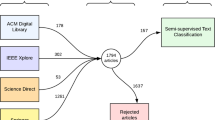Abstract
Though the utility of domain ontologies is now widely acknowledged in the IT (Information Technology) community, several barriers must be overcome before ontologies become practical and useful tools. A critical issue is the ontology construction, i.e., the task of identifying, defining, and entering the concept definitions. In case of large and complex application domains this task can be lengthy, costly, and controversial (since different persons may have different points of view about the same concept). To reduce time, cost (and, sometimes, harsh discussions) it is highly advisable to refer, in constructing or updating an ontology, to the documents available in the field. Text mining tools may be of great help in this task. The work presented in this paper illustrates the guidelines of SymOntos, ontology management system, and the text mining approach adopted herein to support ontology building. The latter operates by extracting, from the related literature, the prominent domain concepts and the semantic relations among them.
Similar content being viewed by others
References
M. Missikoff et al., “A tourism ontology for small and medium enterprises in European market,” LEKS, FETISH Project, Deliverable D1.1, IASI-CNR, Rome, 2000.
M. Uschold and M. Gruninger, “Ontologies: Principles, methods and applications,” The Knowledge Engineering Review, vol. 11, no.2, 1996.
“IDEF5 ontology description capture method overview,” available at http://www.idef.com/overviews/idef5.htm.
“SymOntos, a symbolic ontology management system,” available at http://www.symontos.org.
P.-K. Halvosen, “Document processing,” CH7, in Survey of the State of Art in Human Language Technology, edited by R. Cole, 1995.
“Information extraction: A multidisciplinary approach to an emerging technology,” Lecture Notes in Artificial Intelligence 1299, edited by M.T. Pazienza, Springer: Heidelberg, 1997.
A. Farquhar, R. Fikes, W. Pratt, and J. Rice, “Collaborative ontology construction for information integration,” available at http://www-ksl-svc.stanford.edu:5915/doc/projectpapers.html.
M. Missikoff, “OPAL—A knolwedge-based approach for the analysis of complex business system,” LEKS, IASI-CNR, Rome, 2000.
R.J. Brachman, “On the epistemological status of semantic networks,” in Associative Networks—Representation and Use of Knowledge by Computers, edited by N.V. Findler, Academic Press: New York, NY, 1979.
S. Khoshafian and R. Abnous, Object Orientation: Concepts, Languages, Databases, User Interfaces, JohnWiley: New York, NY, 1990.
J.F. Sowa, Knowledge Representation—Logical, Philosophical, and Computational Foundations, Brooks/Cole, Thomson Learning, 2000.
M. Missikoff and X.F. Wang, “Consys—A group decision-making support system for collaborative ontology building,” in Proc. of Group Decision & Negotiation 2001 Conference, La Rochelle, France, 2001.
D. Skuce, “Conventions for reaching agreement on shared ontologies,” in Proc. of the 9th Knowledge Acquisition for Knowledge Based Systems Workshop, 1995.
A. Farquhar, R. Fikes, W. Pratt, and J. Rice, “Collaborative ontology construction for information integration,” available at http://www-ksl-svc.stanford.edu:5915/doc/projectpapers.html.
R. Basili, M.T. Pazienza, and P. Velardi, “An empyrical symbolic approach to natural language processing,” Artificial Intelligence, no. 85, pp. 59–99, 1996.
E. Brill, “A simple rule-based part-of-speech tagger,” in Proc. of Third Conf. on Applied Natural Language Processing-ANLP92, Trento, Italy, 1992.
A. Cucchiarelli, D. Luzi, and P. Velardi, “Semantic tagging of unknown proper nouns,” in Natural Language Engineering, December 1998.
A. Cucchiarelli, V. Karkaletsis, G. Paliouras, C. Spyropolous, and P. Velardi, “Automatic adaptation of proper noun dictionaries through cooperation of machine learning and probabilistic methods,” in Proc. of 23rd Annual SIGIR, Athens, Greece, 2000.
R. Basili, M.T. Pazienza, and F. Zanzotto, “Customizable modular lexicalized parsing extraction,” in Proc. of Int. Workshop on Parsing Technology, Povo (Trento), Italy, February 2000.
C. Jacquemin, “Variation terminologique,” Memoire d'Habilitation Directeur des Recherces and Informatique Fondamentale, Université de Nantes, Nantes, France, 1997.
J. Klavans, “Text mining techniques for fully automatic glossary construction,” in Proc. of the HTL2001 Conference, San Diego, CA, 2001.
B. Daille, “Study and implementation of combined techniques for automatic extraction of terminology,” in Proc. of ACL94 Workshop—The Balancing Act: Combining Symbolic and Statistical Approaches to Language, New Mexico State University, Las Cruces, New Mexico, 1994.
R. Basili, G. De Rossi, and M.T. Pazienza, “Inducing terminology for lexical acquisition,” in Proc. of the Second Conference on Empirical Methods in Natural Language Processing, Providence, USA, 1997.
R. Fano, Trasmission of Information, MIT Press: Cambridge, MA, 1961.
E. Morin and C. Jacquemin, “Projecting corpus-based semantic links on a Thesaurus,” in Proc. of 37th ACL Conference, 1999.
P. Vossen, “Extending, trimming and fusing WordNet for technical documents,” in Proc. NAACL-2001 Workshop on WordNet and Other Lexical Resources: Applications, Extensions and Customizations, 2001.
A. Miller, “WordNet: An on-line lexical resource,” Special Issue of the Journal of Lexicography, vol. 3, no.4, 1990.
P. Velardi, M. Missikoff, and R. Basili, “Identification of relevant terms to support the construction of domain ontologies,” in Proc. of ACL-01 Workshop on Human Language Technologies, Toulouse, France, 2001.
Y. Wilks, B. Slator, and L. Guthrie, Electric Words: Dictionaries, Computers, and Meaning, MIT Press: Cambridge, MA, 1996.
A. Wagner, “Enriching a lexical semantic net with selectional preferences by means of statistical corpus analysis,” in Proc. of ECAI-2000 Workshop on Ontology Learning, available at http://ol2000.aifb.uni-karlsruhe.de/, Berlin, Germany, 2000.
E. Agirre, O. Ausa, E. Havy, and D. Martinez, “Enriching very large ontologies using the WWW,” in Proc. of ECAI-2000 Workshop on Ontology Learning, available at http://ol2000.aifb.unikarlsruhe.de/, Berlin, Germany, 2000.
A. Maedche and S. Staab, “Learning ontologies for the semantic web,” available at http://www.aifb.uni-karlsruhe.de/WBS/ama/publications.html.
Author information
Authors and Affiliations
Rights and permissions
About this article
Cite this article
Missikoff, M., Velardi, P. & Fabriani, P. Text Mining Techniques to Automatically Enrich a Domain Ontology. Applied Intelligence 18, 323–340 (2003). https://doi.org/10.1023/A:1023254205945
Issue Date:
DOI: https://doi.org/10.1023/A:1023254205945




